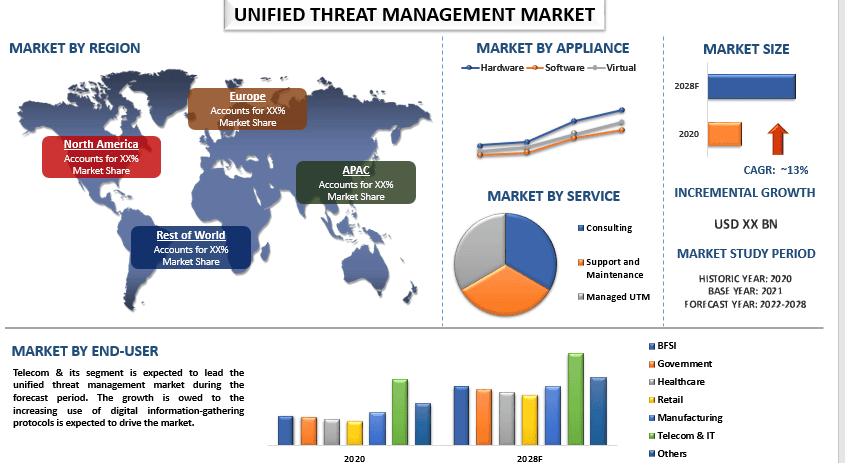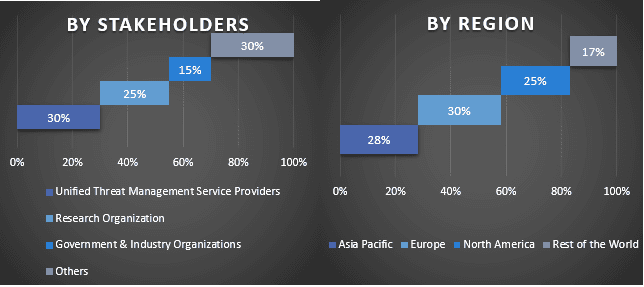Unified Threat Management Market: Current Analysis and Forecast (2022-2028)
Emphasis on Appliance (Hardware, Software, and Virtual); Services (Consulting, Support and maintenance, and Managed Services); Deployment (On-Premises and Cloud); End-User (BFSI, Government, Healthcare, Retail, Manufacturing Telecom and It, and Others) and Region/Country

Global Unified Threat Management Market is expected to grow at a significant rate of around 13% during the forecast period. Unified Threat Management (UTM), is a Next Generation Firewall (NGFW), and a single security solution that provides multiple security capabilities from a single point on the platform or network. UTM applications include features such as network firewall, antivirus, antispam, antispyware, intrusion prevention and detection, leak prevention, and content filtering. Some units also provide services such as network address translation, remote routing and virtual private network support.
The unified threat management market is growing on account of increasing instances of data breaches across industries. For instance, according to comparitech,45% of the U.S. companies have experienced data breaches. Furthermore, UTM solutions offer various benefits such as meeting regular compliance requirements and a reduction in technical training requirements. Moreover, the growing investments in the cybersecurity industry is also expected to influence the market significantly. For instance, according to embroker, global cumulative spending on cyber security products exceeded $1 trillion over the five years 2017-2021 worldwide.
Barracuda Networks Inc, Check Point Software Technologies Ltd, Cisco Systems Inc, Comodo Security Solutions Inc, SonicWall, Fortinet inc, Hillstone Networks, IBM Corporation, Intel Corporation, and Sophos Ltd. are some of the key players in the market. Several M&As along with partnerships have been undertaken by these players to facilitate customers with hi-tech and innovative products/technologies.
Insights Presented in the Report
“Amongst appliance, hardware category to witness significant market share in 2020”
Based on the appliance, the market is categorized into hardware, software, and virtual. The hardware segment is expected to with a significant market share during the forecast period. The growth is mainly attributed to the growing adoption of UTM devices in different organizations. Furthermore, the growing technological advancements in the UTM hardware and growing investment is expected to drive the market during the forecast period.
“Amongst Service, the support and maintenance segment is expected to hold a significant CAGR during the forecast period”
On the basis of service, the market is segmented into consulting, support and maintenance, and managed UTM. The support & maintenance segment is expected to grow with a significant CAGR during the forecast period. This is mainly due to the growing demand for experienced well-trained technicians and elevating need for third-party support and maintenance. Furthermore, the growing demand for consulting services for the protection of significant is also expected to propel the market during the forecast period.
“North America to hold a significant share in the market”
North American region is expected to lead the integrated threat management market during the forecast timeline. The increase in adoption in this region is primarily due to the expansion of cloud security in the region. In addition, the presence of major companies in the region investing heavily in research and development of integrated threat management services. In addition, increasing SMEs in the North American region are expected to drive the market in this region.
Reasons to buy this report:
- The study includes market sizing and forecasting analysis validated by authenticated key industry experts.
- The report presents a quick review of overall industry performance at one glance.
- The report covers an in-depth analysis of prominent industry peers with a primary focus on key business financials, product portfolio, expansion strategies, and recent developments.
- Detailed examination of drivers, restraints, key trends, and opportunities prevailing in the industry.
- The study comprehensively covers the market across different segments.
- Deep dive regional level analysis of the industry.
Customization Options:
The global unified threat management market can further be customized as per the requirement or any other market segment. Besides this, UMI understands that you may have your own business needs, hence feel free to connect with us to get a report that completely suits your requirements.
Table of Contents
Research Methodology for the Unified Threat Management Market Analysis (2022-2028)
Analyzing the historical market, estimating the current market, and forecasting the future market of the global unified threat management market were the three major steps undertaken to create and analyze the adoption of unified threat management in major regions globally. Exhaustive secondary research was conducted to collect the historical market numbers and estimate the current market size. Secondly, to validate these insights, numerous findings and assumptions were taken into consideration. Moreover, exhaustive primary interviews were also conducted, with industry experts across the value chain of the global Unified Threat Management market. Post assumption and validation of market numbers through primary interviews, we employed a top-down/bottom-up approach to forecasting the complete market size. Thereafter, market breakdown and data triangulation methods were adopted to estimate and analyze the market size of segments and sub-segments of the industry pertains to. Detailed methodology is explained below:
Analysis of Historical Market Size
Step 1: In-Depth Study of Secondary Sources:
Detail secondary study was conducted to obtain the historical market size of the unified threat management market through company internal sources such as annual reports & financial statements, performance presentations, press releases, etc., and external sources including journals, news & articles, government publications, competitor publications, sector reports, third-party database, and other credible publications.
Step 2: Market Segmentation:
After obtaining the historical market size of the unified threat management market, we conducted a detailed secondary analysis to gather historical market insights and share for different segments & sub-segments for major regions. Major segments are included in the report as appliance, service, deployment, and end-use. Further country-level analyses were conducted to evaluate the overall adoption of testing models in that region.
Step 3: Factor Analysis:
After acquiring the historical market size of different segments and sub-segments, we conducted a detailed factor analysis to estimate the current market size of the unified threat management market. Further, we conducted factor analysis using dependent and independent variables such as appliance, service, deployment, and end-use of unified threat managements. A thorough analysis was conducted for demand and supply-side scenarios considering top partnerships, mergers and acquisitions, business expansion, and product launches in the unified threat management market sector across the globe.
Current Market Size Estimate & Forecast
Current Market Sizing: Based on actionable insights from the above 3 steps, we arrived at the current market size, key players in the global unified threat management market, and market shares of the segments. All the required percentage shares split, and market breakdowns were determined using the above-mentioned secondary approach and were verified through primary interviews.
Estimation & Forecasting: For market estimation and forecast, weights were assigned to different factors including drivers & trends, restraints, and opportunities available for the stakeholders. After analyzing these factors, relevant forecasting techniques i.e., the top-down/bottom-up approach were applied to arrive at the market forecast for 2028 for different segments and sub-segments across the major markets globally. The research methodology adopted to estimate the market size encompasses:
- The industry’s market size, in terms of revenue (USD) and the adoption rate of the unified threat management market across the major markets domestically
- All percentage shares, splits, and breakdowns of market segments and sub-segments
- Key players in the global unified threat management market in terms of products offered. Also, the growth strategies adopted by these players to compete in the fast-growing market
Market Size and Share Validation
Primary Research: In-depth interviews were conducted with the Key Opinion Leaders (KOLs) including Top Level Executives (CXO/VPs, Sales Head, Marketing Head, Operational Head, Regional Head, Country Head, etc.) across major regions. Primary research findings were then summarized, and statistical analysis was performed to prove the stated hypothesis. Inputs from primary research were consolidated with secondary findings, hence turning information into actionable insights.
Split of Primary Participants in Different Regions

Market Engineering
The data triangulation technique was employed to complete the overall market estimation and to arrive at precise statistical numbers for each segment and sub-segment of the global unified threat management market. Data was split into several segments & sub-segments post studying various parameters and trends in the areas of type, drive type, and application in the global Unified Threat Management market.
The main objective of the Global Unified Threat Management Market Study
The current & future market trends of the global unified threat management market were pinpointed in the study. Investors can gain strategic insights to base their discretion for investments on the qualitative and quantitative analysis performed in the study. Current and future market trends determined the overall attractiveness of the market at a regional level, providing a platform for the industrial participant to exploit the untapped market to benefit from a first-mover advantage. Other quantitative goals of the studies include:
- Analyze the current and forecast market size of the unified threat management market in terms of value (USD). Also, analyze the current and forecast market size of different segments and sub-segments
- Segments in the study include areas of appliance, service, deployment, and end-use.
- Define and analysis of the regulatory framework for the unified threat management
- Analyze the value chain involved with the presence of various intermediaries, along with analyzing customer and competitor behaviors of the industry.
- Analyze the current and forecast market size of the unified threat management market for the major region.
- Major countries of regions studied in the report include Asia Pacific, Europe, North America, and the Rest of the World.
- Company profiles of the Unified Threat Management market and the growth strategies adopted by the market players to sustain in the fast-growing market
- Deep dive regional level analysis of the industry
Related Reports
Customers who bought this item also bought










